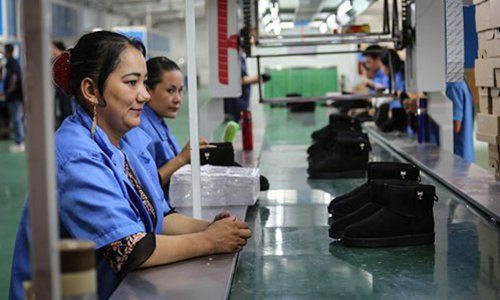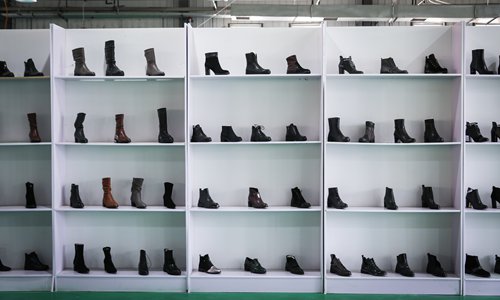HOME >> BUSINESS
Industries drive Hotan development
By Chen Qingqing in Hotan Source:Global Times Published: 2019/7/30 16:25:44
Booming labor-intensive factories boost growth in Xinjiang, helping poverty alleviation

Local workers busy at a shoemaking production line in Hotan, Northwest China's Xinjiang Uyghur Autonomous Region. Photo: Chen Qingqing/GT
While labor-intensive industries in southern China see demographic dividend diminishing due to rising labor and land costs, business representatives from sectors such as shoemaking and textiles see shifting production toward western regions as a promising opportunity. More companies are considering moving to Hotan, Northwest China's Xinjiang Uyghur Autonomous Region.A 23-year-old man surnamed Tohtimamat deftly cemented shoes in a production line at a shoe factory, Yuanfa, located in Moyu County of Hotan. He said he feels happy that he can now support his family with a monthly salary of more than 1,500 yuan ($218.30).
"If I hadn't come to work here, I would have stayed idle at home or toiled in the farmland like my parents, and this work truly helps us to get out of poverty," he told the Global Times on Wednesday.
After a few months of skill training, Tohtimamat has now become a very skilled worker in shoe production line, and he said he hopes to work harder so that he can earn more money, and be able to marry one day.
As a poverty-stricken area, Hotan faces a harsh natural environment, lack of education, and has a heavy reliance on agriculture. In recent years, some prominent Chinese economists have suggested the labor-intensive industries in the eastern regions of China should shift toward western provinces. Hotan could be a pilot area to see poverty alleviation empowered by industries.
Today, in the middle of barren deserts in Hotan, a growing number of industrial parks and factory plants are a common sight, with supporting facilities such as staff dormitory buildings and training centers. Many locals see them as "oases in the desert" that bring people rising hope for a better life.
After more than 30 years of rapid growth, industries in regions such as East China's Zhejiang Province and South China's Guangdong Province have seen rising labor costs as the population dividend is diminishing.
With improving infrastructure in Xinjiang in recent years, the much lower labor cost and favorable government subsidies, an increasing number of companies are now investing in Hotan while industry clusters have begun to take shape.
Meanwhile, the China-proposed Belt and Road Initiative and the China-Pakistan Economic Corridor also offer significant opportunities for the prefecture's new opening-up, as its rail connection with Pakistan and Kyrgyzstan could facilitate cargo trade between China, Central Asia and Central Europe.
"I've been here every year for the past six years, and I see such huge change with the industrial development," Tang Min, who focuses on poverty reduction at the Counselors Office of the State Council, told the Global Times on Wednesday.
A major problem the local economy had faced was a surplus workforce of about 600,000, and many young people were unemployed. Investment in labor-intensive sectors helps create much-needed jobs here, thereby lifting people out of poverty, he said.

Local workers busy at a shoemaking production line in Hotan, Northwest China's Xinjiang Uyghur Autonomous Region. Photo: Chen Qingqing/GT
For better lifeIn a plant in Hotan, roughly 200 workers can be seen sitting in front of operation desks, concentrating on their work, while several managers occasionally appear and give instructions.
"Many workers here are from the Uyghur ethnic group, who may face language barriers during skill training, but they learn very quickly," said a manager at Hedeli, a shoe company headquartered in Southwest China's Sichuan Province that opened a new plant in Hotan few months ago.
Various posters hung on the walls to inspire workers read, "One man employed, a whole family out of poverty," and "Genuine work creates happiness," in both standard Chinese and the language of local ethnic groups. After several months of training, workers can earn more than 1,500 yuan per month, and they will be paid more if they work harder.
In the last two years, more factories from eastern cities have come to invest in new plants in Hotan, with supportive policies such as skill training subsidies, better cargo transport, electricity utilities. For instance, if the shoe factory launches a skill-training program, it will be granted a subsidy of 2,400 yuan per person, according to local authorities.
In 2018, a total of 200,800 people were lifted out of poverty. Urban households in the prefecture saw their disposable income grow by 8 percent year-on-year in 2018, up to 28,610 yuan per year, and rural households saw a growth rate of nearly 9 percent, according to data released by the Hotan government in April.
New 'opening-up'
The companies investing in Hotan, which produce items including shoes, textile products, accessories and even wigs, mainly export their products to overseas markets.
Since Yuanfa's factory began operations earlier this year, it has received orders for 920,812 pairs of shoes.
The Wenzhou-based firm has seen its shipping route to Russia shortened, as the manufacturing base in Hotan is closer to target markets when the company ships its products through the Khunjerab Pass, which links Xinjiang with Pakistan and other regions.
While China, Kyrgyzstan and Uzbekistan recently agreed to build the China-Kyrgyzstan-Uzbekistan railway, Hotan has set its sights on becoming a major city along the route, which is expected to be the shortest route for cargo transport from China to Europe and the Middle East.
"Hotan is in an early stage of an opening-up and reform, with some primary industries that can easily recruit workers with a low technical barrier," Liu Yi, a professor at Peking University, told the Global Times on Wednesday.

Shoes are showcased at a shoemaking factory in Hotan, Northwest China's Xinjiang Uyghur Autonomous Region. Photo: Chen Qingqing/GT
Business to thriveThe pioneer investors who came to establish new factories in Hotan in recent years are facing both opportunities and struggles.
After Liu Zhigao, owner of a shoe factory headquartered in East China's Zhejiang Province, shifted part of business's production to Hotan last year, he had to overcome a difficult period due to insufficient supplies and less-developed logistics services.
"The shoemaking industry involves many processes. Sometimes I need to borrow certain raw materials such as needles or string from my neighbor in this industrial park," Liu told the Global Times.
"It takes much more time to build up a full-scale supply chain for the shoemaking sector," he said.
Local authorities in Hotan began to attract investment from more shoe manufacturers in Hotan from 2017, and until now, the region has seen 537 shoemaking production lines, with a total employment figure of 22,000.
Although some entrepreneurs see these difficulties as temporary, as the region has the potential to become a new shoe-manufacturing hub, they still believe that business will boom with more investment in local infrastructure and the supply chain.
"I'm sure that in the next 10 years, business will thrive here," Liu said.
Posted in: ECONOMY